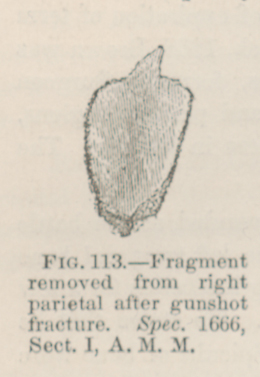Title: Scarborough, Ezra
Source text: Surgeon General Joseph K. Barnes, United States Army, The Medical and Surgical History of the War of the Rebellion. (1861–65.), Part 1, Volume 2 (Washington, D.C.: Government Printing Office, 1870), 226.
Civil War Washington ID: med.d1e15868
TEI/XML: med.d1e15868.xml
CASE.—Corporal Ezra Scarborough, Co. G, 15th New Jersey Volunteers, aged 34 years, was wounded at the battle of Chancellorsville, Virginia, May 3d, 1863, by a musket ball, which fractured and depressed a portion of both tables of the right parietal bone near the vertex. He was sent to a field hospital; thence to Washington, and was admitted into Stanton Hospital, May 8th. The left upper and lower extremities were paralyzed, except the fingers of the left hand, which could be slightly flexed. The paralysis was limited to the motor nerves, those of sensation being unaffected. He complained of headache, and there was some confusion of intellect, though no delirium. The pupils were contracted and symmetrical, but sluggish to stimulus of light. The skin was soft, moist, and natural in temperature. Water dressings and ice were applied to the wound, a saline purgative was administered, and low diet was ordered. The case progressed favorably, and on the 10th, the patient could flex the left elbow. The pupils were still contracted and sluggish, the pulse ranging from 65 to 70. By the 25th, the patient had recovered control of the left arm, though it was not yet as strong as the right ; the pupils were still sluggish, but not contracted; the detached bone appeared elevated. On June 7th, a detached fragment of the inner table, one inch in length and half an inch in width, was removed by Surgeon John A. Lidell, U. S. V. It consisted of diploë and the vitreous table, and when removed, the dura mater and the pulsations of the brain were distinctly visible. The pupils had become natural in size, contracting readily under the stimulus of light; the wound suppurated freely and looked healthy, having slightly contracted. The applications of ice were now discontinued. On the 12th, the pulse had risen from 65 to 80; paralysis of left leg had diminished in a marked degree. June 24th, paralysis was still diminishing, but the patient still complained of headache induced by constipation. July 8th, the brain pulsations were no longer visible, the patient was able to leave his bed, and on August 1st, could walk with the aid of a cane. He continued to improve rapidly, and on the 17th, had recovered sufficiently to go home on furlough. He was transferred to Ward Hospital, Newark, New Jersey, on November 13th, 1863, and was discharged the service on December 11th, 1863, and pensioned. On June 6th, 1866, Pension Examiner E. Swift reports that a deep depression existed over the original seat of injury. There was paralysis of the left side, more marked in the leg than in the arm. The limbs were atrophied and weak, although they preserved their natural movements. The patient suffered a great deal from headache and from severe pain in the affected limbs. His speech was much impaired, and he was unable to do manual labor. His disability was then rated total and permanent. A communication from the Commissioner of Pensions, dated January 3d, 1868, states that Scarborough was a pensioner, his disability being rated total and temporary.
